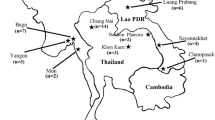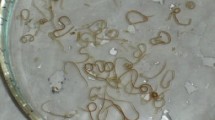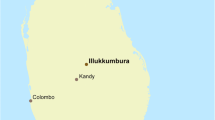Abstract
Polymerase chain reaction (PCR) was applied to identify tissue-embedded ascarid nematode larvae. Two sequences of the internal transcribed spacer (ITS) regions of ribosomal DNA (rDNA), ITS1 and ITS2, of the ascarid parasites were amplified and compared with those of ascarid-nematodes registered in a DNA database (GenBank). The ITS sequences of the PCR products obtained from the ascarid parasite specimen in our laboratory were compatible with those of registered adult Ascaris and Toxocara parasites. PCR amplification of the ITS regions was sensitive enough to detect a single larva of Ascaris suum mixed with porcine liver tissue. Using this method, ascarid larvae embedded in the liver of a naturally infected turkey were identified as Toxocara canis. These results suggest that even a single larva embedded in tissues from patients with larva migrans could be identified by sequencing the ITS regions.
Similar content being viewed by others
Avoid common mistakes on your manuscript.
Introduction
Diagnosis for parasitic diseases is primarily based on morphological identification of worms or eggs. However, practical diagnosis for larva migrans depends largely on serologic tests because of the difficulty of getting tissue-embedded larvae in biopsy materials. Ascarid nematode larvae are particularly minute and similar in morphology (Nichols 1956a, 1956b). Even when a section of larva is found in a histopathological specimen, the species identification is hard unless the typical morphological features can be observed in the section. Since identification of parasite species is important not only for diagnosis but also for epidemiological surveys for public health assessment, a simple and reliable method for the identification of tissue-embedded larvae is desirable. For this purpose we examined the applicability of a nucleotide sequence analysis using polymerase chain reaction (PCR) to identify ascarid larvae in tissues. Each parasite species has unique ribosomal DNA (rDNA) sequences which can be used as markers to distinguish them from closely related and/or morphologically similar species (Hillis and Dixon 1991; Chilton et al. 1995; Gasser et al. 1998). Two sequences of the internal transcribed spacers (ITS) regions of rDNA, ITS1 and ITS2, have been used as species-specific markers for genetic identification (Hoste et al. 1993; Campbell et al. 1995; Zhu et al. 2000). The ITS region sequences of various ascaridoid parasites are now available from DNA databases (DDBJ, EMBL, GenBank).
Materials and methods
Adult ascarid nematodes examined in this study were as follows: Ascaris lumbricoides, Alj-1 and -2 from humans in Miyazaki, Japan; A. lumbricoides, Alb-3 from humans in Bangladesh; A. suum, Asj-1 and -2 from pigs in Miyazaki, Japan; Toxocara canis, Tnj-1 from dogs in Miyazaki, Japan; T. cati, Tcj-1 from cats in Hokkaido, Japan. Because A. lumbricoides and A. suum can hardly be distinguished between (Crompton 2001), we designated the round worm found in humans as A. lumbricoides and that in pigs as A. suum in this study. Worms were obtained from hosts and examined morphologically, then frozen at −70°C or fixed in 70% ethanol. To prepare infective larvae of A. suum, the eggs were obtained from adult females and were incubated in 0.05% formalin at 27°C with aeration for over a month. Mechanical hatching of embryonated eggs was performed as described previously (Urban et al. 1981).
Total genomic DNA was extracted using proteinase K digestion and phenol-chloroform-isoamyl alcohol extraction. ITS1 and ITS2 were amplified by PCR using the following oligonucleotide primers: F2662, 5′-GGCAAAAGTCGTAACAAGGT-3′ (ITS1, forward); R3214, 5′-CTGCAATTCGCACTATTTATCG-3′ (ITS1, reverse); F3207, 5′-CGAGTATCGATGAAGAACGCAGC-3′ (ITS2, forward); R3720, 5′-ATATGCTTAAGTTCAGCGGG-3′ (ITS2, reverse). ITS2 primers used in this study were identical to LC1 and HC2 reported by Navajes et al. (1992). The numbers in the primer names designate the position of the 3′ end of the primer in the published Caenorhabditis elegans sequence (Ellis et al. 1986). PCR reactions were carried out for 45 cycles of 1 min at 92°C, 1 min at 52°C and 1 min at 72°C with PCR buffer including Ampli Taq DNA polymerase (Perkin Elmer, USA). PCR products were detected in 1% agarose gel stained with ethidium bromide and photographed with FAS-III (TOYOBO, Japan). The products were subjected to cycle sequencing using the Big-Dye Terminator cycle sequencing reaction kit (ABI, USA) and sequenced by an automated sequencer (model 310, ABI).
Results and discussion
ITS region sequences of the samples were compared with those registered in the GenBank, which confirmed that there were no differences within the species, then genetic distances between species were calculated by the Kimura-2-parameter method (Kimura 1980) (Table 1). Both ITS regions could be used to distinguish Ascaris parasites from Toxocara spp. An interspecific difference between T. canis and T. cati was observed in the ITS2 region. In the case of Ascaris parasites, no clear genetic distance was observed between A. lumbricoides and A. suum. The extreme similarity of the ITS regions of these two Ascaris has already been reported (Anderson 1995; Zhu et al. 1999). Nevertheless, the sequence difference in the ITS region of Ascaris from humans and pigs was reproducible, and the ITS analysis may be useful for the determination of the original host, i.e. humans or pigs.
To determine the sensitivity of this method, a single larva of A. suum was identified under a dissecting microscope, fixed in 70% ethanol and mixed with approximately 0.005 or 0.01 g porcine liver. Both ITS regions from a single larva of A. suum were amplified (Fig. 1; PCR products for ITS1 and that of ITS2 are not shown) although the DNA extracts required dilution (1:50–100) before amplification. Since this method is sensitive and specific, it can be applied for the genetic identification of ascarid larvae embedded in host tissues.
Results of internal transcribed spacer region amplification by polymerase chain reaction. Lane 1 A single larva of Ascaris suum, lane 2 a single larva with approximately 0.005 g of porcine liver, lane 3 a single larva with approximately 0.01 g of porcine liver, lane 4 porcine liver alone. The molecular weight (bp) is indicated by ➙
As a practical trial of the method, a morphologically unidentified nematode larva found in turkey liver was examined. The turkeys had been kept in the backyard of a patient with visceral larva migrans, probably of A. suum as determined by immunological methods. Because the patient sometimes consumed raw liver of the turkeys, they were suspected to be a source of the infection. Birds, including chickens, could be a paratenic host for A. suum (Permin et al. 2000) as well as T. canis (Galvin 1964; Nagakura et al. 1989). When the livers of the five turkeys were examined, a few minute nodules were found on the surface of all five livers, and the nematode larvae were microscopically detected in the lesions of four out of five turkey livers. After extraction, amplification and sequence analysis of the ITS regions, the larva embedded in a turkey liver was identified as T. canis (Table 2). Indeed, the turkeys has been kept right next to a number of adult dogs and puppies at the patient’s home.
Isolation of larvae from biopsy materials by pepsin or trypsin digestion is possible, but this is bothersome and time-consuming work. Further the digestion is not appropriate for part of a larva in tissue. Processing the whole host tissue containing a larva is much more convenient and there is less risk of losing the parasites. The method described here is sensitive and parasite specific, and can be performed even for a part of a parasite, and is useful for the species identification of worms embedded in host tissue.
The nucleotide sequences determined in this study were deposited in DNA databases (GenBank, EMBL, DDBJ) with accession nos. AB110019–AB110034.
References
Anderson TJC (1995) Ascaris infections in humans from North America: molecular evidence for cross-infection. Parasitology 110:215–219
Campbell AJD, Gasser RB, Chilton NB (1995) Differences in a ribosomal DNA sequence of Strongyloides species allows identification of single eggs. Int J Parasitol 25:359–365
Chilton NB, Gasser RB, Beveridge I (1995) Differences in a ribosomal DNA sequence of morphologically indistinguishable species within the Hypodontus macropi complex (Nematoda: Strongyloidea). Int J Parasitol 25:647–651
Crompton DWT (2001) Ascaris and ascariasis. Adv Parasitol 48:285–375
Ellis RE, Sulston JE, Coulson AR (1986) The rDNA of C. elegans: sequence and structure. Nucleic Acids Res 14:2345–2364
Galvin TJ (1964) Experimental Toxocara canis infections in chickens and pigeons. J Parasitol 50:124–127
Gasser RB, Monti JR, Bao-Zhen Q, Polderman AM, Nansen P, Chilton NB (1998) A mutation scanning approach for the identification of hookworm species and analysis of population variation. Mol Biochem Parasitol 92:303–312
Hillis DM, Dixon MT (1991) Ribosomal DNA: molecular evolution and phylogenetic inference. Q Rev Biol 66:411–453
Hoste H, Gasser RB, Chilton NB, Mallet S, Beveridge I (1993) Lack of intraspecific variation in the second internal transcribed spacer (ITS-2) of Trichostrongylus colubriformis ribosomal DNA. Int J Parasitol 23:1069–1071
Kimura M (1980) A simple method for estimating evolutionary rates of base substitutions through comparative studies of nucleotide sequences. J Mol Evol 16:111–120
Nagakura K, Tachibana H, Kaneda Y, Kato Y (1989) Toxocariasis possibly caused by ingesting raw chicken. J Infect Dis 160:735–736
Navajas M, Cotton D, Kreiter S, Gutierrez J (1992) Molecular approach in spider mites (Acari: Tetranychidae): preliminary data on ribosomal DNA sequences. Exp Appl Acarol 15:211–218
Nichols RL (1956a) The etiology of visceral larva migrans. I. Diagnostic morphology of infective second-stage Toxocara larvae. J Parasitol 42:349–362
Nichols RL (1956b) The etiology of visceral larva migrans. II. Comparative larval morphology of Ascaris lumbricoides, Necator americanus , Stronghloides stercoralis , and Ancylostoma caninum. J Parasitol 42:363–399
Permin A, Henningsen E, Murrell KD, Roepstorff A, Nansen P (2000) Pigs become infected after ingestion of livers and lungs from chickens infected with Ascaris of pig origin. Int J Parasitol 30:867–868
Urban JF Jr, Douvres FW, Tromba FG (1981) A rapid method for hatching Ascaris suum eggs in vitro. Proc Helminthol Soc Wash 48:241–243
Zhu X, Chilton NB, Jacobs DE, Boes J, Gasser RB (1999) Characterisation of Ascaris from human and pig hosts by nuclear ribosomal DNA sequences. Int J Parasitol 29:469–478
Zhu X, Gasser RB, Jacobs DE, Hung G-C, Chilton NB (2000) Relationships among some ascaridoid nematodes based on ribosomal DNA sequence data. Parasitol Res 86:738–744
Acknowledgements
The authors thank Dr H. Takayama, the Abashiri Livestock Hygiene Service Centre, Abashiri, Hokkaido, and the staff of the Meat Inspection Centre, Miyakono-jo, Miyazaki, Kyushu, for providing T. cati and A. suum, respectively. The experiments comply with the current laws of the countries in which the experiments were performed.
Author information
Authors and Affiliations
Corresponding author
Rights and permissions
About this article
Cite this article
Ishiwata, K., Shinohara, A., Yagi, K. et al. Identification of tissue-embedded ascarid larvae by ribosomal DNA sequencing. Parasitol Res 92, 50–52 (2004). https://doi.org/10.1007/s00436-003-1010-7
Received:
Accepted:
Published:
Issue Date:
DOI: https://doi.org/10.1007/s00436-003-1010-7





